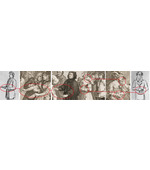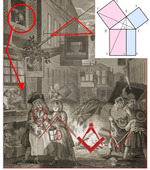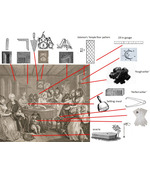A Freemason's Harlot
The artist William Hogarth, is of great interest to the history of the Grand Lodge of England. He was one of the first brothers to be 'raised' in 1725, as this was the very year in which the Third Degree was introduced to the ritual by the nascent organisation.
For reasons that become clear in the book, Hogarth exposed the secret signs of all the degrees by including them within his most popular artwork. He concealed them so masterfully, that they have not been seen for nearly three centuries.
These are not errant details hidden in the background, but are formed by the main characters in some of the most popular prints of all time along with the passwords, secret 'knocks' and many other Masonic symbols.
Hogarth also concealed several details that slandered the Desaguliers, the 'father of Freemasonry' - Jean Desaguliers. The artist featured the third Grand Master covered in wax, dressed in drag, being pushed off a table, and in the act of 'catching a fart'.
Readers will discover three previously unseen self-portraits of Hogarth himself and new sightings of other famous Freemasons: Sir James Thornhill, Inigo Jones, Lord Burlington, Alexander Pope, Orator Henley, 'Butcher' Cumberland and 'Bonnie' Prince Charlie.
Details that have confused art historians for centuries are finally explained: ejaculating ministers, screaming curtains, falling buckets, incorrect clocks, fighting doctors, a stabbed chicken and a fondling pervert. All these have a Masonic link and can help to explain the origin of several parts of Lodge ritual.
Hogarth's artwork also gives us an understanding of a seldom discussed confrontation between the nascent Grand Lodge of England and the Lodges of Jacobite Freemasons, exiled in France.
New studies have shown that the Duke of Burlington was promoting the Stuart cause in England. Hogarth featured the Duke in several pieces of artwork that hinted at his political affiliation. Hogarth then took the slander further to expose Lord Burlington as a homosexual, casting him as the main character in Hogarth's famous Rake's Progress in several compromising positions.
Bell shows how Hogarth's artwork helped frustrate Jacobite attempts to wrestle control of the Freemasonry in England, thus preventing what would have been an important infiltration into English aristocracy. In turn, Grand Lodge helped to secure Hanoverian rule in Great Britain, and stave off many attempts at a French invasion.
In understanding Hogarth's Masonic artwork, we get an appreciation of how important Grand Lodge was for the very survival of the country.
With over 300 illustrations to explain this fascinating story, it is an easy read, and will be of great interest to the brethren.
ISBN:9780998834214
223 pages
Dimensions 22cm x 28cm
Was £65.00 Now £17.00
A beautiful book - admirable in every way. The amount of illustrative material is astounding. Professor Shesgreen, Engravings by Hogarth (Dover Fine Art, 1973). This meticulous analysis of so many of Hogarths prints is a feast of erudition! Professor David Stevenson, The Origins of Freemasonry (Cambridge University Press, 1990). Its hard to describe the breadth and depth of this work, but believe me, you wont be disappointed! Maine Mason Magazine, USA. (Dec 2017). This most beautiful book, full of excellent illustrations, is a fascinating insight into the cleverness and wit of William Hogarth. Well worth reading. The Square Magazine, England. (Dec 2017). This richly-illustrated book is a rare treat for any brother who is interested in hidden signs and symbols! The Trowel - Grand Lodge of Masons in Massachusetts (Jan 2018).



 Click on the image to enlarge
Click on the image to enlarge




